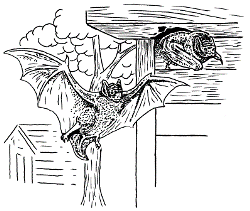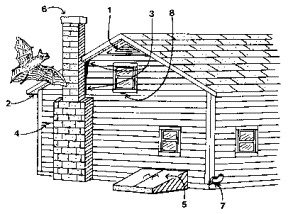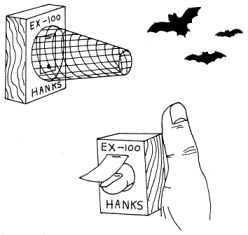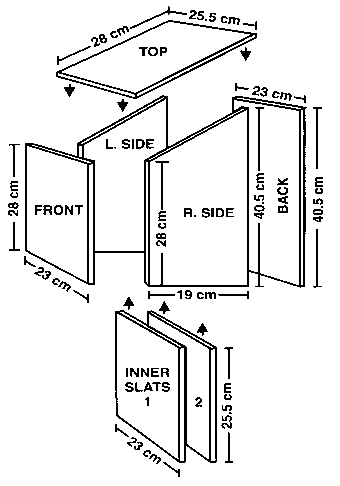
When Bats Become a Nuisance
This article is by Dave Harris
Bats are one of the least understood and persecuted animals. Most people are frightened of bats because of unfounded myths associated with them. Common misconceptions are that bats are blind and they can become tangled in a person's hair.
 Nocturnal mammals, bats sleep during the day and feed at night. They are the only mammals capable of sustained flying. Appearing to fly recklessly, bats' frequent turns and dives help them chase prey such as moths, night-flying beetles, black flies, and mosquitoes. Bats eat up to half their body weight in insects every night.
Nocturnal mammals, bats sleep during the day and feed at night. They are the only mammals capable of sustained flying. Appearing to fly recklessly, bats' frequent turns and dives help them chase prey such as moths, night-flying beetles, black flies, and mosquitoes. Bats eat up to half their body weight in insects every night.
Bats tend to have small eyes and large ears, Instead of using sight, bats rely on a sonar method to guide them on their nightly hunting expeditions. They send out pulses of high-frequency sound and use the returning echo to determine the size, shape, and location of their prey. This is known as echolocation. They have a membrane between their hind legs and tail that acts like a catcher's mitt to trap their food.
Bats belong to the order Chiroptera, meaning "hand wing". Six bat species have been found in Nova Scotia: the little brown bat (Myotis lucifugus), the long-eared bat (Myotis evotis), the eastern pipistrelle (Pipistrellus subflavus), the silver-haired bat (Lasionycteris noctivagans), the red bat (Lasiurus borealis), and the hoary bat (Lasiurus cinereus). The most common species is the little brown bat. It weights about 8 g., is approximately 10 cm long, and has a 25 cm wingspan. The little brown bat may live up to 12 years.
Capable of getting into small areas, bats can crawl through openings as small as 1 cm in diameter. Natural roosts are found under loose tree bark or in the foliage of softwood trees. They often choose barns or attics as a summer home, which causes problems for many people. One or two bats may roost under shingles or clapboard siding, but usually hundreds of bats form colonies in attics, barns, or caves. These colonies usually consist of females who need a place to raise their young. Attics and unoccupied buildings are chosen because the warm temperatures and crowded conditions are desirable nursery sites.
In late August, bats mate and females store sperm over the winter. Females give birth to one young between mid-May and mid-July. The young grow quickly while food is abundant and they gain weight for winter. During late summer, the young learn to fly and hunt for themselves.
When the weather turns colder and the food supply disappears, little brown bats hibernate. They often use caves or abandoned mines for their winter home. In caves, bats find the proper temperature and humidity for survival. Hibernation can last for six to seven months, depending on their fat reserves.
Legal Status
Bats in Nova Scotia have complete legal protection. They cannot be killed without a permit from the Department of Natural Resources and Renewables, which will only be issued after other techniques are unsuccessful.
Damage Identification
There are a few common signs to look for if you suspect a colony of bats is occupying a building. If you observe bats flying in and out of an opening in your house, you have a colony of bats. They are not just feeding near your home. Bat colonies are noisy and messy. Bat droppings build up year after year and small amounts are sometimes visible high on the sides of a house. Not only do these droppings smell and become a health concern (see Disease), they may also cause structural problems to a building.
Prevention Techniques
 The sure way to keep bats out of your house is to block all potential entrances. Bats enter a house through attic vents, cracks and holes under a rotted eave, where the chimney meets the house, openings where pipes and wiring enter the house, through rotten window sills or loose screens.
The sure way to keep bats out of your house is to block all potential entrances. Bats enter a house through attic vents, cracks and holes under a rotted eave, where the chimney meets the house, openings where pipes and wiring enter the house, through rotten window sills or loose screens.
Removal
Sealing off entrances is the best way to keep bats out of your house. The best time to get rid of a colony is in early spring before bats settle, or in late summer after they leave for their hibernation site.
 Cover all openings to your home except the bats' main entrance. Install a one-way door over this entrance, such as a plastic bread bag with the bottom removed. Bats can leave but not re-enter. Once they have all left, permanently seal entrances with foam rubber plugs, screening or caulking. Only use these one-way doors before or after young are present, or able to fly. If installed before young can fly, they will be left behind, dying in your home.
Cover all openings to your home except the bats' main entrance. Install a one-way door over this entrance, such as a plastic bread bag with the bottom removed. Bats can leave but not re-enter. Once they have all left, permanently seal entrances with foam rubber plugs, screening or caulking. Only use these one-way doors before or after young are present, or able to fly. If installed before young can fly, they will be left behind, dying in your home.
Methods such as placing lights in the attic, or using moth balls and annoying fumes are usually ineffective. Bats will roost in the shadows cast by lights or return if the lights are turned off. Fumes can be annoying and sometimes dangerous to people and their pets. Bats will return when the fumes dissipate. Sticky traps catch a few bats, but most learn to avoid them.
People have tried to destroy bat colonies using poisons, but poisons often cause more problems that they solve. Dazed and weakened, poisoned bats may be picked up by children or pets. Dead ones may rot, adding to the odour. Poisons also pose a health hazard to those who live in the house. Under Nova Scotia's Wildlife Act, it is illegal to poison bats.
Disease
Two diseases occasionally associated with bats are rabies and histoplasmosis. Both can be passed on to humans.
Rabies is a serious disease of animals that can be passed to humans. Rabies in humans is rare in North America, however rabies is a serious illness and left untreated can be fatal. Appropriate care and precautions must always be taken when working with or near bats.
Histoplasmosis is a fungal disease associated with bat and bird droppings. If dust containing the fungal spores is inhaled, a lung infection may result. Never stir up bird or bat droppings unless a protective mask is worn. If you try to remove the droppings, wet them with bleach to kill the spores and to minimize the chance of airborne transmission.
Conservation
Bats are part of a natural ecosystem and a healthy environment. They are important in controlling insect populations. To keep bats near your home, but out of your home, put up a bat house. This small-roofed shelter provides the benefits associated with bats without the negative aspects of a colony in your home.
Anyone who finds winter homes of bats should leave without disturbing any bats and reduce their body fat reserves needed to survive the winter. Increased temperatures in caves caused by human body heat can awaken bats. Report the bat cave to local Department of Natural Resources and Renewables.
Build your own bat house to keep bats out of your home, while being able to enjoy their benefits.

Please contact your local Department of Natural Resources and Renewables office for additional information.